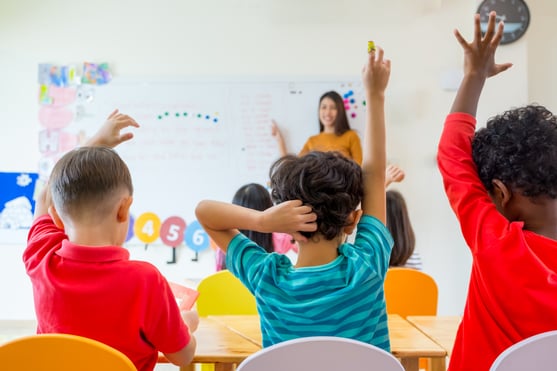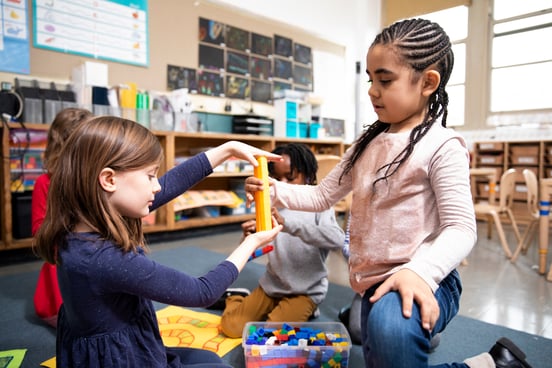
5 Easy Math Engagement Strategies for the Classroom
The news headlines are daunting. Math scores are down. School districts are scrambling to turn things around. And...
ALI Staff | Published January 16, 2024
STEM, representing Science, Technology, Engineering, and Mathematics, is more than an educational buzzword; it's a crucial framework in early childhood education, particularly for preparing preschoolers for the transition to kindergarten.
It lays a solid, multifaceted foundation that goes beyond traditional learning methods, offering a more enriching educational experience.
Educators have the exciting opportunity to enrich the STEM preschool curriculum, creating an academically sound and captivating learning experience for young learners.
The goal should always be to create an environment where preschoolers not only learn but thrive, developing skills essential for their next academic milestone.
Read on to uncover:

Preparing preschoolers to be ready for kindergarten means focusing on more than academic skills.
It's about nurturing a range of abilities that are crucial for their overall growth.
This comprehensive approach, enriched by including STEM for preschoolers, ensures a well-rounded readiness for the structured and interactive environment of kindergarten.
Academic readiness is key in preparing preschoolers for kindergarten. This includes basic literacy skills, such as recognizing letters, understanding phonics, and beginning to read simple words.
These literacy skills ignite a passion for reading and lay the groundwork for effective communication.
In math, it's about counting, knowing numbers, and beginning to grasp concepts like quantity and patterns.
Problem-solving skills are also introduced, fostering critical thinking and analytical abilities that are crucial for all areas of learning.
There's more to readiness than knowing how to hold a book or count to 10. Well-developed social skills are just as important for a successful kindergarten experience.
Sharing, knowing how to play well with others, appropriately expressing feelings, and developing empathy are vital for maintaining a supportive and respectful classroom environment in kindergarten and beyond.
In addition to social and emotional development, fostering a sense of independence and confidence is paramount. Independence in preschoolers can be nurtured through encouraging basic self-care skills and decision-making.
These abilities not only build confidence but also help children feel more secure and self-assured in a new school setting.
Confidence, cultivated through positive reinforcement and the encouragement of curiosity and exploration, empowers preschoolers to engage actively and enthusiastically in their learning journey.
Setting preschoolers up for success in kindergarten involves a delicate balance of teaching academic and non-academic skills.
This comprehensive preparation paves the way for a smooth and successful transition into kindergarten and sets a foundation for a fulfilling educational experience in later grades.
STEM is all about exploring and learning in new ways that get preschoolers ready for kindergarten.
It's not just science and math but also technology and engineering, and it helps preschoolers learn many different skills.
It's a new way of learning that's all about discovery.
When preschoolers do STEM activities, they get to play and see how things work for themselves.
It's a fun way to learn, and it helps them understand big ideas by actually trying things out.
This kind of learning helps kids start thinking independently and figuring out problems.
One of the best things about STEM for preschoolers is that it helps them learn how to think hard and solve tricky problems. They learn that it's okay to make mistakes because that's how they discover new things.
This is important when they go to kindergarten because they'll be trying many new things there.
STEM also helps children become more confident and not give up when something is challenging.
They learn that trying again and again is part of learning, and this helps them keep going and keep learning, even when they start school.
Most importantly, STEM helps students love learning from the start. It prepares them for school and all the learning they will do in their lives.
Harnessing the collective strength of a play-based STEM curriculum, along with story-based and inquiry-based learning, forms the essence of effective STEM education for preschoolers.
These immersive strategies intertwine to construct a learning environment where STEM concepts become engaging, relevant, and fun.
Harnessing the collective strength of a play-based curriculum and story-based and inquiry-based learning forms the essence of effective STEM education for preschoolers.
In play-based learning, preschoolers aren't just playing—they're explorers on a quest, discovering the world with every block they stack and every puzzle they solve.
This is STEM in action: understanding gravity while building towers, learning about geometry through shapes, or exploring biology as they plant seeds and watch them grow.
Play turns complex theories into tangible experiences, fostering a natural and enjoyable learning process.
Inquiry-based learning encourages a child's innate curiosity, prompting them to ask "why" and "how."
This approach complements play and story-based learning, encouraging preschoolers to dig deeper.
As they investigate how plants grow or why the sun sets, they're laying the groundwork for scientific inquiry and developing critical thinking skills.
The synergy of these three learning approaches creates a holistic STEM experience. As preschoolers play, they learn to solve problems creatively.
As they listen to stories, they build confidence in their ability to understand complex concepts. And as they ask questions, their curiosity blossoms into a passion for lifelong learning.
By integrating these methods into preschool STEM education, we do more than prepare children for kindergarten.
We equip them with a toolkit of skills—creativity, problem-solving, critical thinking—that are essential for thriving in the fast-paced, ever-evolving world they will navigate.
Preparing preschoolers for the academic structure of kindergarten involves nurturing important literacy, communication, and math skills.
These foundational abilities are not just building blocks for school; they're vital for sparking a lifelong journey of learning and discovery.
Reading in the preschool years is a magical time when every book opened is a new world discovered.
Preschoolers learn to navigate through narratives, understand characters, and grasp the rhythm of language in stories.
Including nonfiction texts in their reading list is equally important. It exposes them to real-world concepts, broadening their understanding and vocabulary.
Books about animals, plants, or the stars engagingly introduce factual information, planting the seeds of curiosity about the natural world.
When we weave STEM themes into both fiction and nonfiction reading, we naturally introduce preschoolers to scientific and mathematical concepts.
A story might take them on a journey through the life of a frog, or an informational text could explain the shapes and functions of different leaves. This fusion of storytelling with STEM creates a richer narrative that educates as it entertains.
Before they start writing sentences, preschoolers express their ideas through stories they tell and scenarios they enact.
This pretend play is crucial, as it allows them to communicate complex thoughts and emotions, setting the stage for the written word.
They learn to articulate ideas, argue points, and narrate stories—skills that are the precursors to formal writing.
Introducing STEM into their verbal exercises, preschoolers might explain how they built a tower block by block or describe the steps in a simple experiment.
These activities encourage them to use specific language and details, which are essential for later writing tasks. Talking about their STEM experiences helps them organize their thoughts and communicate them clearly.
In preschool, math is woven into the fabric of play. Children learn about numbers when they set the table, understand size when they sort their toys, and discover geometry as they piece together puzzles.
These playful interactions are the early stages of mathematical reasoning.
STEM activities bring math into focus in a tangible way.
Counting flower petals introduces addition, arranging rocks by size touches on measurement, and grouping objects by color teaches sorting.
Such hands-on experiences demystify math concepts, making them part of everyday exploration and fun.
Integrating STEM with the 3 Rs helps ensure that preschoolers are academically prepared for kindergarten as well as enthusiastic learners.
They build the confidence to explore, question, and learn—a mindset that will benefit them far beyond their first day of school.
STEM activities for preschoolers need to be interactive and engaging, sparking curiosity while building foundational skills.
These activities encourage exploration and learning through play, stories, and inquiry.
Here are some ideas for implementing STEM in the preschool curriculum:
Sensory bins are a staple in preschool science exploration, inviting children to dive hands-on into learning about the physical world.
Filling these bins with a variety of materials, such as water, sand, or rice, provides a tactile experience that teaches about different textures, substances, and natural elements.
A water bin, for example, becomes a mini-ocean where various objects can be tested for whether they float or sink, illustrating basic physics concepts like buoyancy and density.
To extend this exploration, challenge preschoolers to create a vessel that can carry a small toy or figure without tipping or sinking.
This addition not only reinforces the principles of buoyancy but also encourages design thinking and problem-solving.
Building blocks are more than just toys; they are the tools of young engineers.
By using these simple construction sets, preschoolers face challenges that stretch their imagination and critical thinking.
For instance, when asked to construct the tallest possible tower with a limited number of blocks, they learn about balance, stability, and the importance of a strong foundation.
Replicating a 2D design in a 3D format with these blocks further enhances their spatial awareness and introduces them to the concept of following a design plan.
The story of "The Three Little Pigs" can be more than a favorite preschool narrative.
Teachers can easily turn it into a lesson in materials engineering. After engaging with the tale, preschoolers are presented with the challenge of constructing homes from straw, sticks, and blocks.
Testing these structures against the 'huff and puff' of a big bad wolf, simulated by a fan or hairdryer, brings an element of real-world engineering into the classroom.
This activity not only teaches about material properties and construction techniques but also makes a direct connection between the strength of a structure and its ability to withstand forces, a fundamental concept in engineering.
Building bridges is a practical example of engineering for preschoolers, introducing them to basic engineering concepts.
Provide various materials such as popsicle sticks, clay, straws, or blocks, and challenge the children to construct bridges that can support weight.
They'll learn about structure and balance as they try to strengthen their bridge enough to hold toys or other objects. As they experiment with different designs and materials, they engage in problem-solving and critical thinking.
They'll understand why some structures stand while others fall and what makes a bridge sturdy. It's a hands-on way to apply engineering and science knowledge in a creative, collaborative setting.
An engaging activity to explore physics with preschoolers involves creating ramps of varying heights and slopes.
Using simple materials like cardboard or wooden planks, children can construct their own ramps and then race different objects down them. They can use cars, balls, or even homemade rollers.
By observing which objects roll down faster or slower, children learn about gravity, speed, and the impact of slope on movement.
This activity not only introduces basic principles of physics but also encourages preschoolers to predict outcomes and understand the cause-and-effect relationships that govern motion.
Early encounters with science, technology, engineering, and mathematics do more than just prepare kids for kindergarten.
They spark a sense of wonder and an eagerness to learn that can last a lifetime.
STEM isn't just about academic skills; it's about helping little ones see the fun in learning and the thrill of solving problems.
Every ramp they build, every story they hear, and every question they ask lays down a path to a world where they're confident, curious, and ready to take on new challenges.

The news headlines are daunting. Math scores are down. School districts are scrambling to turn things around. And...

Math assessment in California is changing. What used to be a compliance exercise or reporting tool is now becoming a...

You know the moment: a student’s eyes light up when the science experiment fizzes or the math puzzle helps them...